From the Field: Bill Buck in Cape Horn 2013, Day Nine
Posted in Bill Buck, From the Field, Science on March 1 2013, by William R. Buck
January 18, 2013, Prov. Antártica Chilena, Comuna Cabo de Hornos, Isla Hoste, Bahía Tekenika, 55°18’S, 68°39’W
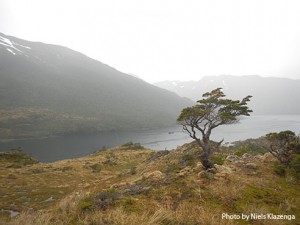 It’s been a long day. Initially we planned to leave Seno Ponsonby at 3 a.m, but instead at 10 p.m. we travel for an hour and then tie up to some rocks for the night, leaving again at 5 a.m. and arriving at our current location around 8:30 a.m. The captain and motorman spent most of yesterday working on some mechanical problem I didn’t understand until this morning when I learned that one of the ship’s two batteries would not recharge. This placed a limit on various electrical functions. It appeared as if we might need to go to Puerto Williams early and have someone fly in to fix it. However, miracle Nano (the motorman) managed to fix it today. Apparently this is why we had been traveling in daylight, because the loss of charge was affecting the navigational equipment. I was a bit nervous about all this and chose not to discuss it with the group. Fortunately, everything now seems fine.
It’s been a long day. Initially we planned to leave Seno Ponsonby at 3 a.m, but instead at 10 p.m. we travel for an hour and then tie up to some rocks for the night, leaving again at 5 a.m. and arriving at our current location around 8:30 a.m. The captain and motorman spent most of yesterday working on some mechanical problem I didn’t understand until this morning when I learned that one of the ship’s two batteries would not recharge. This placed a limit on various electrical functions. It appeared as if we might need to go to Puerto Williams early and have someone fly in to fix it. However, miracle Nano (the motorman) managed to fix it today. Apparently this is why we had been traveling in daylight, because the loss of charge was affecting the navigational equipment. I was a bit nervous about all this and chose not to discuss it with the group. Fortunately, everything now seems fine.
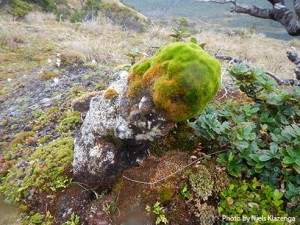 All this activity means a slow start this morning. However, about 10:30 we ferry ashore to find one of the most difficult terrains I have ever tried to traverse. There are more downed trees than standing ones, stacked one on top of another at every conceivable angle. In addition, there are numerous large boulders. The whole landscape is coated with a carpet of hornworts, adding a highly precarious nature to our collecting because they are intensely mucilaginous.
All this activity means a slow start this morning. However, about 10:30 we ferry ashore to find one of the most difficult terrains I have ever tried to traverse. There are more downed trees than standing ones, stacked one on top of another at every conceivable angle. In addition, there are numerous large boulders. The whole landscape is coated with a carpet of hornworts, adding a highly precarious nature to our collecting because they are intensely mucilaginous.
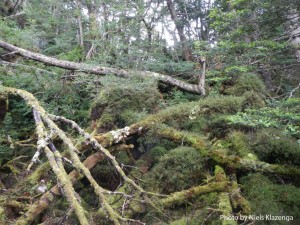 At times I think I am standing on the ground only to find I am actually on a log a good 10 feet above the ground. Every step is a struggle. However, the collecting is good and so we are each doing the best we can. Half an hour before our appointed pick-up I look up and notice that I can see the life jackets on the shore only about 50 yards ahead, and yet, given the treacherous nature of the landscape, I cannot be sure that 30 minutes will be enough time to make it punctually. I start out on a more or less direct route, and reach a drop-off much too far to consider scaling down. So, I retrace my steps and try a different way. By the time I reach the shore, I am exhausted and drenched in sweat. I have never been so happy to see that Zodiac!
At times I think I am standing on the ground only to find I am actually on a log a good 10 feet above the ground. Every step is a struggle. However, the collecting is good and so we are each doing the best we can. Half an hour before our appointed pick-up I look up and notice that I can see the life jackets on the shore only about 50 yards ahead, and yet, given the treacherous nature of the landscape, I cannot be sure that 30 minutes will be enough time to make it punctually. I start out on a more or less direct route, and reach a drop-off much too far to consider scaling down. So, I retrace my steps and try a different way. By the time I reach the shore, I am exhausted and drenched in sweat. I have never been so happy to see that Zodiac!
Back on the ship we have lunch and I start processing my collections. Because this location has proven so wet, every specimen needs to be rebagged. I take any dry collections off the dryer and make room for today’s gatherings. While I am processing my collections, the others head into the field. At last I finish my work and suit up to head out again.
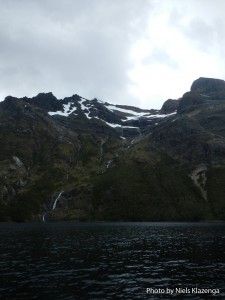 I am taken to the opposite side of the bay from the others, next to a small stream. In short order I see that the stream is cascading down the mountainside and is actually a series of small waterfalls. The entire stream is choked with aquatic bryophytes, and for once not just hepatics. Eurhynchium fuegianum covers the rocks in the stream and Vittia pachyloma is equally abundant, but submerged. After working up the stream I decide to work back down the slope in the forest. Once again the blasted hornworts make for slippery going. However, collecting is good and is so much easier than in the morning that I don’t mind. Little, curious songbirds chirp all around me, obviously not accustomed to those invading their little corner of paradise.
I am taken to the opposite side of the bay from the others, next to a small stream. In short order I see that the stream is cascading down the mountainside and is actually a series of small waterfalls. The entire stream is choked with aquatic bryophytes, and for once not just hepatics. Eurhynchium fuegianum covers the rocks in the stream and Vittia pachyloma is equally abundant, but submerged. After working up the stream I decide to work back down the slope in the forest. Once again the blasted hornworts make for slippery going. However, collecting is good and is so much easier than in the morning that I don’t mind. Little, curious songbirds chirp all around me, obviously not accustomed to those invading their little corner of paradise.
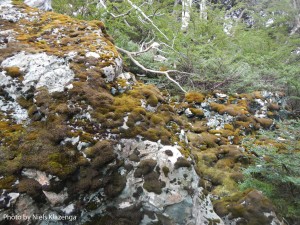 Upon returning to the ship, my highest priority is a shower and clean clothes. It is amazing how glorious a small, tight shower stall with limited hot water can be. Showers and how much hot water there is, or isn’t, are a popular conversation topic. We discovered last night that Niels, who is a computer programmer, couldn’t figure out how to turn on the hot water. Admittedly, it is confusing because the hot is actually on the other side than it is labeled. However, everyone else has figured it out and we all got a good laugh after Niels admits he has just finished his third cold shower. I trust from now on he’ll have at least some hot water!
Upon returning to the ship, my highest priority is a shower and clean clothes. It is amazing how glorious a small, tight shower stall with limited hot water can be. Showers and how much hot water there is, or isn’t, are a popular conversation topic. We discovered last night that Niels, who is a computer programmer, couldn’t figure out how to turn on the hot water. Admittedly, it is confusing because the hot is actually on the other side than it is labeled. However, everyone else has figured it out and we all got a good laugh after Niels admits he has just finished his third cold shower. I trust from now on he’ll have at least some hot water!
It is now 8 p.m. and the last of our group are coming in from the field. There is still about another three hours of daylight today. But now that the ship is back to full function there is no need to hurry to Puerto Williams. I understand we will spend the night here and move onto the Hardy Peninsula tomorrow morning. Between my bad Spanish and the captain’s strong Chiloé accent, we each only understand only about a third of what the other is saying. Despite this, we seem to do just fine.
Once again the weather today was surprisingly good. We had a few light showers, but nothing serious and little if any wind. If this keeps up, the new members of our group will think I have made up how bad the weather was the previous two years!
Ed. note: NYBG scientist and Mary Flagler Cary Curator of Botany, Bill Buck has just returned from his annual expedition to the islands off Cape Horn, the southernmost point in South America, to study mosses and lichens. For the past two years he was able to file stories from the field, but this year’s locations proved so remote he was forced to wait until his return. We will be publishing them over the course of several days. Follow his journeys on Plant Talk.
Bill Buck’s Previous Reports From the Field:
2013
January 10, 2013, Punta Arenas, Chile
2012
February 5, 2012; Isla Londonderry, Puerto Fortuna, approximately 54º54’S, 70º26’W
February 4, 2012; Isla O’Brien, Caleta Americana, approximately 54º53’S, 70º23’W
February 3, 2012; Isla Grande de Tierra del Fuego, Fiordo Garibaldi, approximately 54º58’S, 69º49’W
February 2, 2012; Isla Gordon, middle arm of Bahía Tres Brazos, approximately 54º58’S, 69º41’W
January 31, 2012; Isla Gordon, Bahía Romanche, 54º57’S, 69º30’W
January 30, 2012; Isla Gordon, Bahía Romanche, 54º57’S, 69º30’W
January 25, 2012; Isla Darwin, Caleta Virginia, approximately 54º57’S, 70º10’W
January 23, 2012; Arm of Estero Webb, SW coast of Isla Hoste, approximately 55º14’S, 69º41’W
January 22, 2012.; Unnamed sound on Isla Gordon behind Cabo El Gorro, approximately 55º02’S, 69º48’W
January 21, 2012; Isla Hoste, Estero Fouque, 55º1’S, 69º35’W
January 20, 2012; Isla Hoste, Estero Fouque, approximately 55º11’S, 69º35’W
January 18, 2012; Canal O’Brien, just south of Isla O’Brien, 54º55’S, 70º35’W
January 17, 2012; Punta Arenas, Chile
2011
July 15, 2011; Hobart, Tasmania, Australia
July 14, 2011; Pyengana, Tasmania, Australia
July 13, 2011; Weldborough, Tasmania, Australia
July 12, 2011; Hobart, Tasmania, Australia
July 11, 2011; Hobart, Tasmania, Australia
February 8, 2011; Punta Arenas, Chile
February 5, 2011, unnamed sound northwest of Isla Georgiana
February 4, 2011, unnamed sound directly east of Seno Mama, Chile
February 2, 2011, Seno Courtenay, northern arm, Chile
February 1, 2011, Seno Courtenay, Chile
January 31, 2011, Canal between Isla Georgiana and Isla Clementina,, Chile
January 30, 2011, Unnamed sound on south side of Brecknock Peninsula, NW of Isla Georgiana, Chile
January 29, 2011, Isla Aguirre, Seno Quo Vadis, Chile
January 26, 2011, Punta Arenas, Chile
January 24, 2011, Seno Chasco, just north of isthmus to Brecknock Peninsula, Chile
January 23, 2011, Isla Grande de la Tierra del Fuego, Puerto Consuelo, Seno Chasco, Chile
January 22, 2011, Isla Grande de la Tierra del Fuego, Seno Brujo, Chile
January 21, 2011, Isla Grande de la Tierra del Fuego, Seno Brujo, Chile
January 20, 2011, Isla Grande de la Tierra del Fuego, Seno Bluff, Chile

